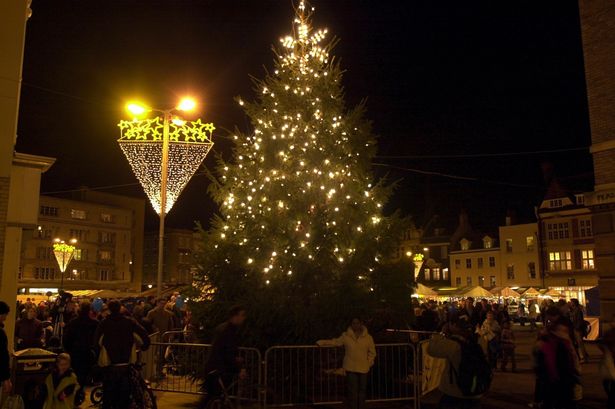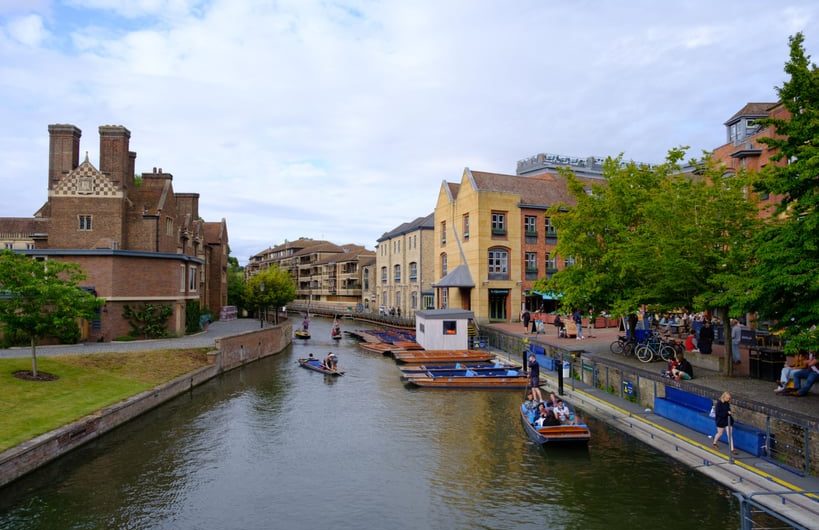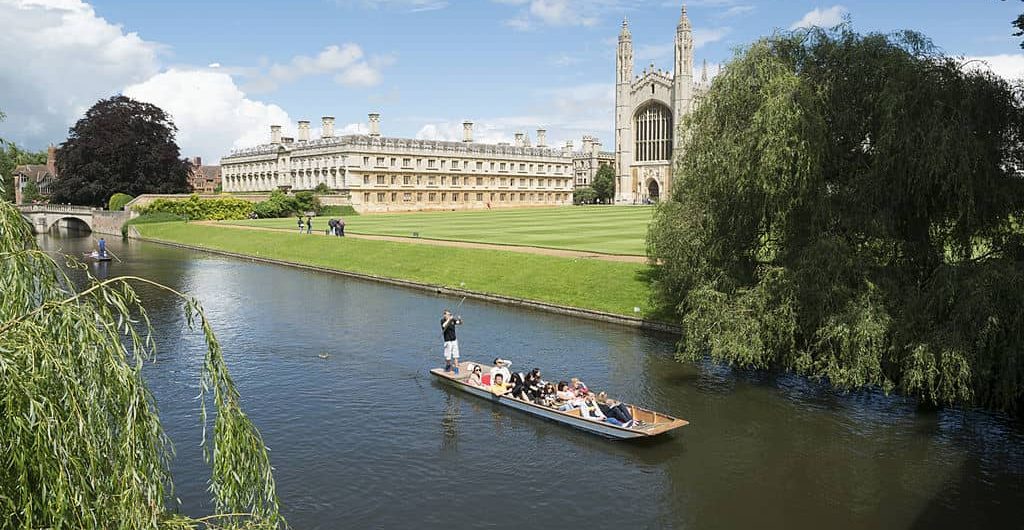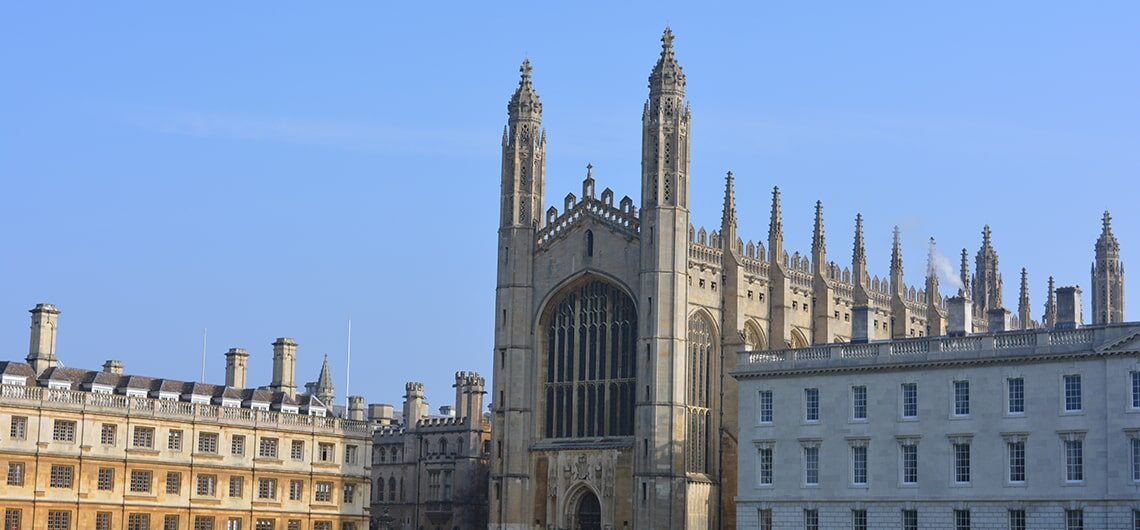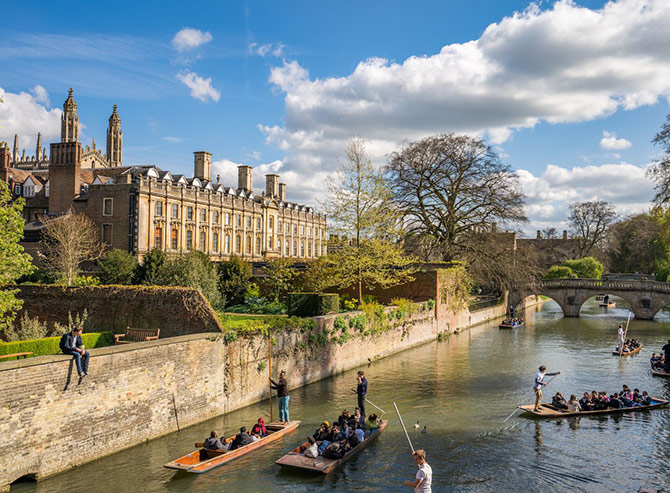Gliding down the River Cam, getting fascinated by the serenity the environment offers, your mind gets tranquilized and you feel as if you have stepped back in time into an old Dickens novel. Read our punting guide on everything you need to know before punting in Cambridge A Brief History of Naming of Cambridge Around the 12th century, Cambridge was found around the area of Castle Mount and it became the head of navigation of the then called River Granta. Cambridge soon became an important trading port thus arising a need for a bridge. It was at this time the Norwich architect Arthur Browne built the Great Bridge called the Magdalene Bridge. The bridge is a single span of cast iron bridge terminating in ashlar piers and surmounted by an iron railing. The Great Bridge was the only bridge crossing the Granta at that time, and people used to call it ‘Grentebrige’, ‘Cantebrigge’ in accordance with the name of the river, Granta. The name did not become ‘Cambridge’ until much later. By that time, the town was called ‘Cambridge’, this gave the bridge its name, ‘Cambridge’ and the assumption was that the river must therefore be ‘Cam’, and so that was what it became. The River Cam Cambridge is on the River Cam which has a total distance of approximately 40 miles from Cambridge to the sea. The River Cam is the main river flowing in Eastern England. After leaving Cambridge, the river flows north and east into the Great Ouse to the south of Ely at Pope’s Corner. It is the Great Ouse that connects the Cam to the North Sea at King’s Lynn. It is the Great Ouse that connects England’s canal system via the Midlevel Navigations and the River Nene. Thus, the River Cam runs for around
Gliding down the River Cam, getting fascinated by the serenity the environment offers, your mind gets tranquilized and you feel as if you have stepped back in time into an old Dickens novel.
Read our punting guide on everything you need to know before punting in Cambridge
A Brief History of Naming of Cambridge
Around the 12th century, Cambridge was found around the area of Castle Mount and it became the head of navigation of the then called River Granta. Cambridge soon became an important trading port thus arising a need for a bridge. It was at this time the Norwich architect Arthur Browne built the Great Bridge called the Magdalene Bridge. The bridge is a single span of cast iron bridge terminating in ashlar piers and surmounted by an iron railing. The Great Bridge was the only bridge crossing the Granta at that time, and people used to call it ‘Grentebrige’, ‘Cantebrigge’ in accordance with the name of the river, Granta. The name did not become ‘Cambridge’ until much later. By that time, the town was called ‘Cambridge’, this gave the bridge its name, ‘Cambridge’ and the assumption was that the river must therefore be ‘Cam’, and so that was what it became.
The River Cam
Cambridge is on the River Cam which has a total distance of approximately 40 miles from Cambridge to the sea. The River Cam is the main river flowing in Eastern England. After leaving Cambridge, the river flows north and east into the Great Ouse to the south of Ely at Pope’s Corner. It is the Great Ouse that connects the Cam to the North Sea at King’s Lynn. It is the Great Ouse that connects England’s canal system via the Midlevel Navigations and the River Nene. Thus, the River Cam runs for around 43 miles from Debden in Essex to its confluence with Great Ouse.
It plays a vital role in Cambridge’s life. Not just famous for punting, people spend their free time at riverside parks, bars and restaurants.
Punting in Cambridge
The boat on the river Cam popularly known as a punt is long, narrow flat-bottomed and squared at both ends. It is designed for its use in shallow water and is propelled with a long pole. It generally has seating for 4 adults and a fifth person stands at the rear and he propels the boat with the pole. Punts are commonly used on inland waters chiefly for recreation. Not just in Cambridge, but also in Oxford, Canterbury and Kent in the UK, punts are commonly seen. Although a Punt seems similar to the Venetian Gondola, they are different in many aspects. Unlike a punt, a Gondola has an oar for propagation instead of the pole and is structurally different from the former too.
Originated from the word punt, Punting is the act of gliding smoothly along the river on a punt and enjoying the eye-catching view. The one who drives the punt by standing on it and propelling the pole is called a Punter. Every punting tour company in Cambridge offers the service of a Punter who is not just a Chauffeur but also is omniscient in the history of Cambridge. Punting is not an easy task as it appears. It needs high skill and hence it is always advisable to opt for a Chauffeured Punt.
Punting in Cambridge is an indelible adventure of gliding through the famous College Backs in the heart of the city. You ought to witness the architectural excellences of 7 riverside colleges, including Magdalene, St John’s, Trinity, Trinity Hall, Clare, King’s and Queen’s College, during your punting trip. And if you are in a chauffeured punt, the punter would explain the compelling history of Cambridge and its Universities.
Discover the charm of the River Cam and enchant the aroma of the daffodils and cherry blossoms by hopping into a punt and appreciating the serene environment!
Places to Punt in Cambridge
There are two places to punt in Cambridge. The most popular one is at the Backs of Cambridge; here you’ll trip by glancing at the Bridge of Sighs, the Mathematical Bridge and the King’s College. This exhibits the architectural masterpieces at Cambridge.
The other place is Grantchester; a quieter and serene place. If you are planning to enjoy the beauty of the environment by punting yourself, then Grantchester is the right place to do it. You can even stop at a riverside pub for a dine.
The Backs of Cambridge
The Cambridge Backs is an area to the east of Queen’s Road in the city of Cambridge. Located at central Cambridge along the banks of the River Cam, the scenic route of the Backs covers some of the most famous and prestigious colleges that together form the Cambridge University. The Back’s and King’s College has been rated as one of the top ten views in England by the National Trust.
The name Backs actually refers to the backs of the colleges. The Backs has seven Cambridge University Colleges situated in its area. Punting from north to south, we see :
- Magdalene College
- St John’s College
- Trinity College
- Clare College
- King’s College
- Queen’s College
The Back provides phenomenal views throughout the year and will be covered with a blanket of daffodils, cherry blossoms, and crocuses during the spring.
In the heart of hectic medieval city of Cambridge, Backs thrives to be an area of absolute serene and idyllic. Wide open spaces, cattles grazed in well manicured lawns, gleaming old architectural masterpieces, tranquil river banks where people choose to relax during the summer months are the characteristics of Cambridge Backs.
The Grantchester
Located at a short distance from the center of Cambridge, this village is not just notable for its serene, but for a small village, its brains. There are a lot of Nobel Prize Winners from Grantchester, many of whom worked at Cambridge University earlier. The Grantchester has got a medieval church and a few thatched cottages. The pool in Grantchester where Lord Byron is popular over the nation.
Tourist Attractions In Cambridge
Even Though Cambridge is globally famous for its prestigious University, that is not all it has. Cambridge claims to have one of the highest concentrations of preserved historic buildings anywhere in the United Kingdom. A greater percentage of the history, tradition and architectural masterpiece is contributed by the 31 colleges of Cambridge University.
Immigrant scholars from Paris established schools in the 12th century. And they founded the first college, Peterhouse in 1284.
Cambridge was an eminent Norman fortification before the University came into existence. Castle Mound, which can still be seen near Shire Hall imparts greater ambiance to the city. Cambridge is an important market town till date. Being the center of Cambridge’s ancient wool trade, Market Hill still continues to be one of the busy marketplaces in the city.
Although Cambridge is popular for its romantic medieval character, it is actually a modern town that always updates with the latest trends and thus hosts a variety of top-notch cultural events throughout the year. The cultural activities include the 800 year old Midsummer Fair that is still held in the same location on Midsummer Common, the famous Cambridge Folk Festival, and a world-class film festival.
Cambridge is well known for its numerous green spaces which include the 25 acres Parker’s Piece and Victorian era’s Christ’s Pieces. Parker’s Piece is esteemed as the birthplace of modern football and Christ’s Pieces is notable for its stunning ornamental trees and flowerbeds.
But above all, the most red-lettered memory Cambridge can ever provide you would be its exclusive punting experience. Punting through the River Cam should be the Top 1 priority in your Bucket List as gliding through the heart of the city offers astonishing and incredible views.
Here is a list of the 14 best tourist attractions in Cambridge, although there are numerous fascinating spots all over the city
Kings College and King’s College Chapel
The college has a huge expanse of lawn that extends down the river and King’s Bridge. The choir from the King’s College Chapel is a refreshment for your mind.
Queen’s College and the Mathematical Bridge
The college possess the most complete medieval buildings of Cambridge University. The magnificent gateway leading to the red brick First Court and the masterpiece Mathematical Bridge are a never to miss tourist spots.
Cambridge University Botanical Garden
With more than 8000 species of plants to exhibits, this is an absolute wonder for then garden enthusiasts.
Great St Mary’s Church and the Round Church
This spot which is both a Parish and University church, has a 1608 built tower which adds to view of Cambridge.
Trinity College
It has the largest court in Cambridge, the Trinity Court.
The Fitzwilliam Museum
This most famous museum with a masterpiece of architecture contains a speechless collection of illuminated manuscripts, English and Chinese pottery, and Greek, Roman, and Egyptian antiquities.
Anglesey Abbey, Gardens, and Lode Mill
Known as the house of fine arts and furnishing, the breathtaking home contains numerous tapestries.
Museum of Archaeology and Anthropology
Contains innumerous collection of prehistoric material and artifacts collected from all around the world.
Peterhouse College
The oldest college of Cambridge
Pembroke College
The Pembroke Chapel is famous as architect Wren’s first work. The college grounds and Chapel are good tourist destinations.
Corpus Christi College
The college library possess a collection of valuable manuscript. The college has made summer accommodations available for tourists.
St. John’s College
It is a fine example of Tudor architecture. Almost every rooms in this building possess splendid architectural excellences.
Museums of Cambridge, Technology, and Science
This museum is popular for exhibiting displays that focus on almost all everyday products of local people of 18th to 20th century.
National Horse Racing Museum
It provides a memorable visit for the horse fans by exhibiting products related to the history of the “sport of kings”.

